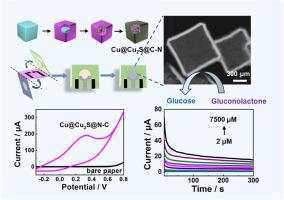当前位置:
X-MOL 学术
›
Anal. Chim. Acta
›
论文详情
Our official English website, www.x-mol.net, welcomes your feedback! (Note: you will need to create a separate account there.)
An origami microfluidic paper device based on core-shell Cu@Cu2S@N-doped carbon hollow nanocubes
Analytica Chimica Acta ( IF 5.7 ) Pub Date : 2024-06-12 , DOI: 10.1016/j.aca.2024.342828 Yuanyuan Li , Huinan Chen , Rong Huang , Dongmei Deng , Xiaoxia Yan , Liqiang Luo
Analytica Chimica Acta ( IF 5.7 ) Pub Date : 2024-06-12 , DOI: 10.1016/j.aca.2024.342828 Yuanyuan Li , Huinan Chen , Rong Huang , Dongmei Deng , Xiaoxia Yan , Liqiang Luo

|
The global prevalence of diabetes mellitus, a serious chronic disease with fatal consequences for millions annually, is of utmost concern. The development of efficient and simple devices for monitoring glucose levels is of utmost significance in managing diabetes. The advancement of nanotechnology has resulted in the indispensable utilization of advanced nanomaterials in high-performance glucose sensors. Modulating the morphology and intricate composition of transition metals represents a viable approach to exploit their structure/function correlation, thereby achieving optimal electrocatalytic performance of the synthesized catalysts. Herein, a sensitive and rapid Cu-encapsulated CuS@nitrogen-doped carbon (Cu@CuS@N–C) hollow nanocubes-functionalized microfluidic paper-based analytical device (μ-PAD) was fabricated. Through a delicate sacrificial template/interface technique and thermal decomposition, inter-connected hollow networks were formed to boost the active sites, and the carbon shell was coated to protect Cu from being oxidation. For application, the constructed μ-PAD is used for glucose sensing utilizing an origami automated sample pretreatment system enabled by a simple application of strong alkaline solution on wax paper. Under optimal circumstances, the Cu@CuS@N–C electrochemical biosensor exhibits broad detection range of 2–7500 μM (R = 0.996) with low detection limit of 0.16 μM (S/N = 3) and high sensitivity of 1996 μA mM cm. Additionally, the constructed μ-PAD also exhibited excellent selectivity, stability, and reproducibility. By rationally designing the double-shell hollow nanostructure and introducing Cu-encapsulated inner layer, the synthesized Cu@CuS@N–C hollow nanocubes show large specific surface area, short diffusion channels, and high stability. The proposed origami μ-PAD has been successfully applied to serum samples without any additional sample preparation steps for glucose determination, offering a new perspective for early nonenzymatic glucose diagnosis.
中文翻译:

基于核壳Cu@Cu2S@N掺杂碳空心纳米立方体的折纸微流控纸器件
糖尿病是一种严重的慢性疾病,每年给数百万人带来致命的后果,其全球患病率备受关注。开发高效、简单的血糖水平监测设备对于管理糖尿病至关重要。纳米技术的进步导致先进纳米材料在高性能葡萄糖传感器中不可或缺的应用。调节过渡金属的形态和复杂的组成是利用其结构/功能相关性的可行方法,从而实现合成催化剂的最佳电催化性能。在此,制造了一种灵敏快速的铜封装的CuS@氮掺杂碳(Cu@CuS@N-C)空心纳米立方体功能化微流控纸基分析装置(μ-PAD)。通过精致的牺牲模板/界面技术和热分解,形成互连的中空网络以增强活性位点,并涂覆碳壳以防止铜被氧化。在应用方面,构建的 μ-PAD 用于葡萄糖传感,利用折纸自动样品预处理系统,通过在蜡纸上简单应用强碱性溶液即可实现。在最佳情况下,Cu@CuS@N–C电化学生物传感器表现出2–7500 μM(R = 0.996)的宽检测范围,低检测限为0.16 μM(S/N = 3)和1996 μA mM cm的高灵敏度。此外,构建的μ-PAD还表现出优异的选择性、稳定性和重现性。通过合理设计双壳空心纳米结构并引入Cu封装内层,合成的Cu@CuS@N-C空心纳米立方体表现出大的比表面积、短的扩散通道和高的稳定性。 所提出的折纸μ-PAD已成功应用于血清样品,无需任何额外的样品制备步骤即可进行葡萄糖测定,为早期非酶葡萄糖诊断提供了新的视角。
更新日期:2024-06-12
中文翻译:

基于核壳Cu@Cu2S@N掺杂碳空心纳米立方体的折纸微流控纸器件
糖尿病是一种严重的慢性疾病,每年给数百万人带来致命的后果,其全球患病率备受关注。开发高效、简单的血糖水平监测设备对于管理糖尿病至关重要。纳米技术的进步导致先进纳米材料在高性能葡萄糖传感器中不可或缺的应用。调节过渡金属的形态和复杂的组成是利用其结构/功能相关性的可行方法,从而实现合成催化剂的最佳电催化性能。在此,制造了一种灵敏快速的铜封装的CuS@氮掺杂碳(Cu@CuS@N-C)空心纳米立方体功能化微流控纸基分析装置(μ-PAD)。通过精致的牺牲模板/界面技术和热分解,形成互连的中空网络以增强活性位点,并涂覆碳壳以防止铜被氧化。在应用方面,构建的 μ-PAD 用于葡萄糖传感,利用折纸自动样品预处理系统,通过在蜡纸上简单应用强碱性溶液即可实现。在最佳情况下,Cu@CuS@N–C电化学生物传感器表现出2–7500 μM(R = 0.996)的宽检测范围,低检测限为0.16 μM(S/N = 3)和1996 μA mM cm的高灵敏度。此外,构建的μ-PAD还表现出优异的选择性、稳定性和重现性。通过合理设计双壳空心纳米结构并引入Cu封装内层,合成的Cu@CuS@N-C空心纳米立方体表现出大的比表面积、短的扩散通道和高的稳定性。 所提出的折纸μ-PAD已成功应用于血清样品,无需任何额外的样品制备步骤即可进行葡萄糖测定,为早期非酶葡萄糖诊断提供了新的视角。











































 京公网安备 11010802027423号
京公网安备 11010802027423号